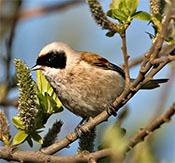Press release 2013-01-09 at 12:00
|
|

|
|
The Eurasian Penduline Tit will
become more common in Finland as
the climate warms.
Photo: Jorma Tenovuo.
|
On the basis of studies carried out by the Finnish Environment Institute, the current areas of occupancy of bird species living in forest, mire and arctic mountain areas will contract as a consequence of climate change. However, protected areas will considerably slow down the decline in our bird life. Bird species living in marshlands will benefit from a warmer climate. They will spread towards the north and southern marshland bird species will colonize Finland.
A recent study published in the international Biodiversity and Conservation series examined projected changes in the areas of occupancy of bird species that are of nature conservation importance and that will live in forest, mire, marshland and Arctic mountain areas in Finland during the next 40–70 years in terms of the current protected area network. According to forecasts, the probability of occurrence of all species other than those living in marshlands will decline in Finland. Declining species will include many owl species and waders living in mire areas.
The rate of decline of birds is known to be higher in areas other than protected areas. Finland’s protected area network will significantly mitigate the adverse effects of climate change on our bird life.
Strongest decline in southern Finland
The projected decline of species will be strongest in the southern boreal zone and lowest in the northern boreal zone. This is because species currently occurring in the southern boreal zone are projected to increasingly move into the northern boreal zone.
The rate of decline is also expected to be stronger in regions with only a few protected areas than in regions with a higher number of such areas. As regards forests, in particular, the conservation area network in southern and central Finland is still insufficient to ensure the preservation of our diverse bird life.
The study examined the projected probability of occurrence of a hundred bird species of conservation concern and live in forest, mire, marshland and Arctic mountain areas in Finland in the period 2051–2080. The analysis also included ten species that do not yet breed in Finland, but occur south of Finland. These species, such as the Middle Spotted Woodpecker (Dendrocopos medius) and the Marsh Tit (Parus palustris), are likely to spread to Finland as the climate warms.
The study was part of a project Assessing limits of adaptation to climate change and opportunities for resilience to be enhanced (A-LA-CARTE), carried out under the FICCA research programme (Finnish Research Programme on Climate Change).
Article
Further information
Leading Researcher, docent Raimo Virkkala, Finnish Environment Institute, tel. +358 400 148 668, firstname.lastname@environment.fi
Photo for media
The Spotted Redshank (Tringa erythropus) breeding in northern mires is projected to decline due to climate change. Photo: Markku Aikioniemi.